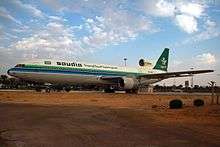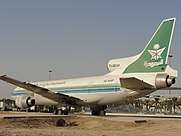Lockheed L-1011 TriStar
The Lockheed L-1011 TriStar, commonly referred to as the L-1011 (pronounced "L-ten-eleven") or TriStar, is an American medium-to-long-range, wide-body trijet airliner by Lockheed Corporation. It was the third wide-body airliner to enter commercial operations, after the Boeing 747 and the McDonnell Douglas DC-10. The airliner has a seating capacity of up to 400 passengers and a range of over 4,000 nautical miles (7,410 km). Its trijet configuration has three Rolls-Royce RB211 engines with one engine under each wing, along with a third engine center-mounted with an S-duct air inlet embedded in the tail and the upper fuselage. The aircraft has an autoland capability, an automated descent control system, and available lower deck galley and lounge facilities.
| L-1011 TriStar | |
|---|---|
.jpg) | |
| Delta Air Lines L-1011-1 TriStar on final approach at Fort Lauderdale–Hollywood International Airport in 1998 | |
| Role | Wide-body jet airliner |
| Manufacturer | Lockheed Corporation |
| First flight | November 16, 1970 |
| Introduction | April 26, 1972 with Eastern Air Lines |
| Status | In limited service |
| Primary users | Northrop Grumman
|
| Produced | 1968–1984 |
| Number built | 250 |
| Unit cost |
US$20M (1972)[1] |
| Variants | |
The L-1011 TriStar was produced in two fuselage lengths. The original L-1011-1 first flew in November 1970 and entered service with Eastern Air Lines in 1972. The shortened, longer range L-1011-500 first flew in 1978 and entered service with British Airways a year later. The original-length TriStar was also produced as the high gross weight L-1011-100, up-rated engine L-1011-200, and further upgraded L-1011-250. Post-production conversions for the L-1011-1 with increased takeoff weights included the L-1011-50 and L-1011-150.
The L-1011 TriStar's sales were hampered by two years of delays due to developmental and financial problems at Rolls-Royce, the sole manufacturer of the aircraft's engines. Between 1968 and 1984, Lockheed manufactured a total of 250 TriStars, assembled at the Lockheed plant located at the Palmdale Regional Airport in southern California north of Los Angeles. After production ended, Lockheed withdrew from the commercial aircraft business due to its below-target sales.[2] As of 2020, the L-1011 is the last non-Russian wide-body airliner to enter production that was not manufactured by the Airbus and Boeing duopoly or their predecessor companies.
Development
Origins
In the 1960s, American Airlines approached Lockheed and competitor Douglas (later McDonnell Douglas) with the need for an airliner which could carry 250 passengers on transcontinental routes.[3] Lockheed had not produced civilian airliners since 1961 with the L-188 Electra. In the 1950s the Electra was designed for turboprop propulsion, which Lockheed had successfully used on the C-130 Hercules military transport. Even after the Electra overcame vibration problems that caused several crashes early in its career, the market for large airliners would soon shift over to jet airliners such as the Boeing 707 and Douglas DC-8.[4][5][6] Lockheed won contracts for jet military transports with the C-141 StarLifter, and pioneered very large jet transports with the large C-5 Galaxy with its high-bypass turbofan engines. Boeing lost the military contract, but its private-venture 747 captured what would become a much larger civilian airliner market for wide-body airliners.
Having experienced difficulties with some of their military programs, Lockheed was eager to re-enter the civilian market with a smaller wide-body jet, and their response was the L-1011 TriStar. Douglas Aircraft answered American Airlines with the DC-10, which had a similar three-engine configuration and dimensions.[7] Despite their similarities, the L-1011 and DC-10's engineering approach differed greatly. McDonnell, who had recently taken over Douglas Aircraft, directed DC-10 development on a "very firm budget, and cost overruns were unacceptable – even at the expense of safety", and the conservative approach meant reusing Douglas DC-8 technology. By contrast, Lockheed would "take the most advanced technology of the day and when that technology was lacking, Lockheed created it" for the L-1011[8] in order to give it lower noise emissions (in the early 1970s, Eastern Air Lines nicknamed the L-1011 "WhisperLiner"), improved reliability, and higher efficiency over first-generation jet airliners. The TriStar name was selected in a Lockheed employee naming contest for the airliner. The advanced technology that went into the TriStar resulted in a high purchase price. It has been said that "airlines could get a 747 for slightly more, or a DC-10 for a good deal less".[9]
The TriStar's design featured a twin-aisle interior with a maximum of 400 passengers and a three-engine layout. The TriStar was originally conceived as a "jumbo twin", but a three-engine design was ultimately chosen to give the aircraft enough thrust to take off from existing runways.[7] Also, before the establishment of Extended Operations standards by the FAA in the 1980s, commercial jets with only two engines were not allowed to fly more than 30 minutes away from an airport, making trans-oceanic flights impossible. The main visible difference between the TriStar and its similar trijet competitor, the McDonnell Douglas DC-10, is the central tail engine configuration: the DC-10's engine is mounted above the fuselage for simplicity of design and more economical construction, while the TriStar's engine is mounted to the rear fuselage and fed through an S-duct (similar to the Boeing 727) for reduced drag and improved stability.[9][10] Lockheed engineers were able to maintain straight-through engine performance by limiting the curve of the S-duct to less than a quarter of the radius of the engine intake diameter. The S-duct design also reduced the total empty aircraft weight. The research undertaken during the design of the L-1011 indicated that losses of using an S-duct were more than compensated for by the above savings.[11] A further major difference between the L-1011 and the DC-10 was Lockheed's selection of the Rolls-Royce RB211 as the only engine for the L-1011.[12][13] As originally designed, the RB211 turbofan was an advanced three-spool design with a carbon fiber fan,[14] which would have better efficiency and power-to-weight ratio than any competing engine like the General Electric CF6 that powered the DC-10. In theory, the triple spool would produce the same or more power as existing double spool engines while having a smaller cross section that would reduce drag.[8][9]
American Airlines opted for the Douglas DC-10, although they showed considerable interest in the L-1011. American intended to convince Douglas to lower their price for the DC-10, which they did.[15] Without the support of American, the TriStar was launched on orders from TWA and Eastern Air Lines.

Although the TriStar's design schedule closely followed that of its competitor, McDonnell Douglas beat Lockheed to market by a year due to delays in powerplant development. In February 1971, after massive development costs associated with the RB211, Rolls-Royce went into receivership.[16][17] This halted L-1011 final assembly and Lockheed investigated the possibility of a US engine supplier.[18] However the engineering was finalized at that stage in the TriStar's development and its S-duct, which was designed to fit the smaller cross-section of the triple spool RB-211 engine that would have reduced drag, was too small in diameter to accommodate an existing double spool engine.[9] One option presented was potential outsource of RB-211 production to Canadian manufacturer Orenda Engines.[19]
The British government agreed to approve a large state subsidy to restart Rolls-Royce operations on condition the U.S. government guarantee the bank loans Lockheed needed to complete the L-1011 project.[Note 1] Despite some opposition, not least from the then Governor of California, Ronald Reagan, the U.S. government provided these guarantees.[21] For the rest of the RB211 project, Rolls-Royce remained a government-owned company.[22]
Production
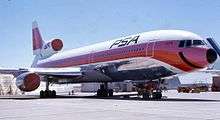
The TriStar's internal Lockheed model number is L-093. The TriStar was manufactured in Lockheed facilities in Burbank and Palmdale, California.
Lockheed discovered fairly early on that the TriStar suffered from higher than estimated structural weight, engine weight, and specific fuel consumption. To rectify this problem and to meet performance guarantees, Lockheed developed a structural kit that allowed maximum takeoff weight (MTOW) to be increased on production aircraft from 409,000 to 430,000 pounds (186,000 to 195,000 kg). However, the weight problems affected the weight and desirability of early production L-1011-1 aircraft, known as Group 1 (serial numbers 1002 through to 1012).
Group 1 aircraft have an OEW of 252,700 pounds (114,600 kg), about 12,700 pounds (5,800 kg) higher than later aircraft, while Group 2 aircraft (serial numbers 1013 through 1051) have an OEW of 247,000 pounds (112,000 kg), some 4,700 pounds (2,100 kg) lower. These aircraft, in general, also have different center of gravity envelopes with the forward center of gravity limit on the early aircraft being more restrictive at higher gross weights. Groups 1 and 2 aircraft (serial numbers 1002 to 1051) are upgradeable only to -50 or -150 specifications, although the Group 1 aircraft (up to serial number 1012) still maintain their operating disadvantages. All L-1011-1 aircraft from serial number 1052 onwards are Group 3 aircraft and are fully upgradeable to all variants up to -250 specification.
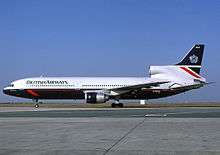
Under state control, costs at Rolls-Royce were tightly controlled and their efforts largely went into the original TriStar engines, which needed considerable modifications between the L-1011's first flight and service entry. The competition, notably General Electric, was very quick to develop their CF6 engine with more thrust, which meant that a heavier "intercontinental" DC-10-30 could be more quickly brought to market. The flexibility afforded to potential customers by a long-range DC-10 put the L-1011 at a serious disadvantage. Rolls-Royce went on to develop the high-thrust RB211-524 for the L-1011-200 and -500, but this took many years.[23]
The resultant delay in Lockheed and Rolls-Royce offering a high gross variant with a longer range, coupled with the TriStar's delayed introduction, meant that only 250 TriStars were sold compared to some 400 DC-10s.[9] Lockheed needed to sell 500 airliners to break even, but in 1981, the company announced production would end with the delivery of the 250th and last L-1011 on order in 1984.[24][25]
The TriStar's failure to achieve profitability caused Lockheed to withdraw from the civilian aircraft business.[2] The TriStar's rivalry with the DC-10 has been seen as a "case study in what can happen when two manufacturers attempt to split a market that simply could not support both aircraft". Lockheed lacked the resources to follow up with several proposals based on the TriStar wing and airframe, including a wide-body twinjet and a stretched quad-jet (one of the quadjet proposals consisting of two underwing engines and two rear fuselage-mounted engines). McDonnell Douglas was also financially weakened and could only develop the MD-11, a refinement of the DC-10, instead of an all-new design to challenge the next generation of twinjets like the Boeing 777.[8]
Design
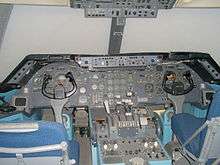
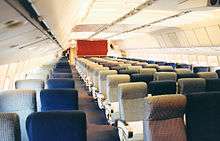
The L-1011 featured a highly advanced autopilot system and was the first widebody to receive FAA certification for Cat-IIIc autolanding, which approved the TriStar for completely blind landings performed by the aircraft's autopilot in zero-visibility weather.[26] The L-1011 used an inertial navigation system to navigate;[27][28] this included aligning the navigation system by entering current coordinates of longitude and latitude.[8]
It also had a unique direct lift control (DLC) system, which allowed for smooth approaches when landing, without having to use significant pitch changes while on the approach path.[29][30] DLC helps maintain the aircraft on the glideslope during final approach by automatically deploying spoiler panels on the wings. Thus, rather than maintaining the descent by adjusting pitch, DLC helps control the descent while maintaining a more consistent pitch angle, using four redundant hydraulic systems. The production also used a unique "autoclave" system for bonding fuselage panels together; this made the L-1011 extremely resistant to corrosion.
Operational history
Commercial
The prototype first flew on November 16, 1970.[31] The crew for that flight was H. B. Dees (pilot), Ralph C. Cokely (copilot), and G.E. Fisher (development engineer). The L-1011 was certified on April 14, 1972, with the first airliner delivered to Eastern Air Lines on April 26, 1972.[31] To further publicize the new aircraft, an L-1011 was taken on a world tour during 1972 by famed Lockheed test pilot Tony LeVier. In a demonstration by test pilots LeVier and Charles Hall, 115 crew members, employees, and reporters embarked on the TriStar for a 4-hour, 13-minute flight from Palmdale to Dulles Airport "with the TriStar's AFCS [Automatic Flight Control System] feature engaged from takeoff roll to landing", and Lockheed touted it as "a groundbreaking moment: the first cross-country flight without the need for human hands on the controls".[32]
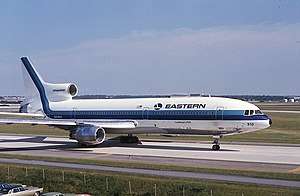
TWA heralded the TriStar as one of the safest aircraft in the world in promotional literature in the 1980s when concern over the safety record of the McDonnell Douglas DC-10, flown by rival airlines, was at its peak.[31] The L-1011 has been involved in five fatal accidents, only one of which was due to a problem with the aircraft.[33]
Delta Air Lines was the type's largest customer.[34] Delta retired its TriStars in 2001 to replace them with the Boeing 767-400ER. Cathay Pacific eventually became the largest non-U.S. operator of the type by acquiring many of the Eastern Air Lines examples when Eastern went bankrupt, operating as many as 21 aircraft. Cathay Pacific retired its L-1011s in October 1996 and replaced the type with the Airbus A330-300. TWA withdrew its last TriStar from service in 1997.
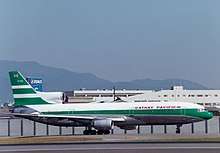
To secure the Japanese market, Lockheed secretly bribed several members of the Japanese government to subsidize All Nippon Airways' purchase of L-1011s; this caused a significant scandal when the bribes were uncovered.[35][36] The discovered scale to what has become known as the Lockheed bribery scandal led to the arrest of Japanese Prime Minister Kakuei Tanaka, as well as several other officials.[37] Within Lockheed, board chairman Daniel Haughton and vice chairman and president Carl Kotchian resigned their posts on February 13, 1976.[38] Tanaka was eventually tried and found guilty of violating foreign exchange control laws but was not charged with bribery, a more serious criminal offense.[39][40] Crucially for Lockheed, the fallout from the scandal included the loss of a contract worth over $1 billion.[41]
The Soviet Union at that time lacked a widebody airliner. Development of its own Ilyushin Il-86 was delayed;[42][43] consequently, in the mid-1970s, the Soviets started negotiations to buy 30 TriStars and license-produce up to 100 a year.[44][45] The talks collapsed as US President Jimmy Carter made human rights an important consideration in US foreign policy.[46][47] The TriStar was also listed by the Coordinating Committee as embodying advanced technology banned from potential enemies, thus being a serious obstacle to the export deal.
In later years the L-1011 has been used by smaller start-up carriers, particularly in Africa and Asia. These operators mainly do their business in the ad hoc charter and wet leasing businesses. ATA Airlines (formerly known as American Trans Air) fleet included over 19 TriStars, but operations dwindled to only three L-1011-500s before the company's shutdown in April 2008. The last commercial TriStar flight operated on January 7, 2019.
Military
The TriStar has also been used as a military tanker and passenger/cargo aircraft. The British Royal Air Force had nine aircraft of four variants. The aircraft were six ex-British Airways and three Pan Am L-1011-500s.[48][49][50] All of the aircraft served with No. 216 Squadron, and were based at RAF Brize Norton. The TriStar was replaced in RAF service by the Airbus A330 MRTT under the Future Strategic Tanker Aircraft program.[51] 216 Squadron was officially disbanded on March 20, 2014 and flew its last sorties with the TriStar on March 24, 2014.[52]
Other
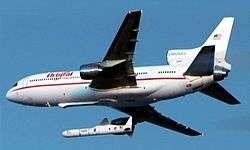
In the early 1990s, Orbital Sciences began to use a converted L-1011-100 named Stargazer to launch Pegasus rockets into orbit around Earth. This venture effectively rendered the small Scout rocket obsolete.[53][54] This aircraft was also used in support of the X-34 and X-43 programs. NASA performed aerodynamic research on Orbital Sciences' L-1011 in 1995.[55] As of 2014, three L-1011s in the world are airworthy.[56]
Variants
The earlier versions of the L-1011, such as the -1, -100, and -150 can be distinguished from the later models by the design of the middle engine nacelles. The earlier version nacelle has a round intake, whereas the later models have a small vertical fin between the bottom of the middle engine intake and the top of the fuselage.
The two L-1011 aircraft delivered to Pacific Southwest Airlines were configured with internal airstair doors that led into an entry hall in what was normally the forward lower baggage hold. This was to allow operations from airfields that did not have terminal buildings with jet bridges. These two aircraft were later in service with Aeroperú and Worldways Canada.
L-1011-1
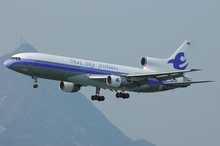
The L-1011-1 (FAA certification L-1011-385-1) was the first production model of the L-1011, designed for short- and medium-range flights. This variant served as the basis for subsequent variants. This type was purchased by Air Canada, ANA, Cathay Pacific, Eastern, and other operators with regional trunk routes requiring a widebody aircraft. Pacific Southwest Airlines purchased two L-1011-1 models with lower deck seating.[57] This variant was also one of the few widebodies to have the option for a full-height built-in airstair.[31]
The L-1011-1 was first delivered to Eastern Air Lines on April 5, 1972. A total of 160 L-1011-1 TriStars were built before production ended in 1983, although the majority of these, 119 or 75% of the total, were completed during a four-year period from 1972 to 1975. Most sales of the L-1011-1 were to US operators, with just three airlines, Delta, Eastern, and TWA, taking delivery of 110 combined. A further two aircraft were placed with a fourth US airline, Pacific Southwest Airlines.[31]
L-1011-100
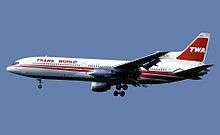
The L-1011-100 (FAA certification L-1011-385-1-15) was the second production model of the L-1011 and first flew in 1975 and featured a new center fuel tank and higher gross weights that increased the aircraft's range by nearly 930 miles (1,500 km). Launch orders for the L-1011-100 were placed by Saudia and Cathay Pacific, for two each, in May 1974. Deliveries began in June 1975.
The variant was also purchased by several airlines with longer-range routes, such as TWA, Air Canada, and BEA (which merged with BOAC to form British Airways). The first two L-1011-100s (serial numbers 1110 and 1116) were delivered new to Saudia with the same fuel capacity as the L-1011-1 (FAA certification L-1011-385-1-14); these were later upgraded to L-1011-200 specification.
L-1011-50
The L-1011-50 was an upgraded version of the L-1011-1 with an increase in maximum takeoff weight from 430,000 pounds (195,000 kg) to either 440,000 pounds (200,000 kg) or 450,000 pounds (204,000 kg). Fuel capacity was not increased. The -50 was available only as a conversion package for the L-1011-1 and was never built new.
L-1011-150
The L-1011-150 was a development of the L-1011-1 with its maximum takeoff weight increased to 470,000 pounds (210,000 kg). It was available only as a conversion for the L-1011-1. The -150 involves the conversion of Group 1 and Group 2 L-1011-1 aircraft to an MTOW of 470,000 pounds (210,000 kg), an increase of 40,000 pounds (18,000 kg), about 10%, from the L-1011-1, giving the aircraft a slightly better range than the -50, but without the additional center-section fuel tank, less than the L-1011-100 aircraft. The first aircraft was converted by MBB at Lemwerder in Germany during the winter of 1988/89 and was subsequently handed over to Air Transat of Canada on May 11, 1989.
L-1011-200
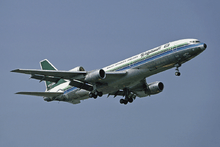
The L-1011-200 (FAA certification L-1011-385-1-15), the third production model of the L-1011, was introduced in 1976. Although otherwise similar to the -100, the -200 uses Rolls-Royce RB.211-524B engines to improve its performance in hot and high-altitude conditions. Gulf Air used -200 models to replace its earlier-generation Vickers VC10 fleet.
Other than the engines, the basic TriStar -200 is identical to the -100, with center-section fuel, having a MTOW of 466,000 pounds (211,000 kg), and fuel capacity of 26,400 US gallons (100,000 l) as the -100. An increase of gross weight to 474,000 pounds (215,000 kg) is possible, with the heavier aircraft offered by Lockheed as -200I or -200(Improved). Saudi Arabian Airlines (Saudia) was a launch customer for the -200 series and operated a sizable fleet until 1998. A total of 24 L-1011-200 aircraft were built new, with the first delivered to Saudia on May 28, 1977. Like other TriStar improvements, a conversion program has also been offered.
L-1011-250
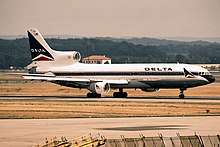
The L-1011-250 was an upgrade developed for late-model L-1011-1 aircraft and all L-1011-100 and L-1011-200 aircraft. The more powerful engines, lengthened wing, active-load-control ailerons and other systems that had been developed for the L-1011-500 were adapted into the baseline model. The changes resulted in increases in maximum takeoff weight to 510,000 pounds (230,000 kg) and fuel capacity from 23,600 US gal (89,335 l) to 31,632 US gal (119,735 l). This variant also used the upgraded RB211-524B4I engine, which could be easily retrofitted to the existing RB211-524B powerplants of the L-1011-200, but it required a re-engining on the L-1011-1 and L-1011-100, which used the original RB211-22B. The conversion allowed the L-1011 to match the performance of the long-range McDonnell Douglas DC-10-30. Although it applied to all L-1011 models, the upgrade was only undertaken by Delta on six late-model L-1011-1 aircraft.
L-1011-500
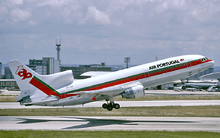
The L-1011-500 (FAA certification L-1011-385-3) was the last L-1011 variant to enter production. It was a longer-range variant first flight-tested in 1978. Its fuselage length was shortened by 14 feet (4.3 m) and MTOW increased to allow higher fuel loads. More powerful RB.211-524 engines, increased wingspan, active-load-control ailerons and other improved systems were features introduced by Lockheed to exploit newly available technologies in the late 1970s. The -500 variant was popular among international operators and formed a significant portion of the L-1011 fleet of Delta and British Airways. However, its late introduction resulted in many potential customers buying the DC-10-30 instead.
The TriStar 500 first flew on October 16, 1978, with the first delivery to British Airways on April 27, 1979. It entered service with British Airways on May 7, 1979, flying between London and Abu Dhabi.
Dimensions
The TriStar 500 has an overall length of 164 feet 2 inches (50.04 m) and wingspan increased to 164 feet 4 inches (50.09 m) (early TriStar versions originally had the TriStar 1 wing with a span of 155 feet 4 inches (47.35 m)).
Flying surfaces
Lockheed developed some aerodynamic improvements for the TriStar 500 which included a modified wing-to-body fairing, a fillet below the central intake, extended wingtips, and "active ailerons" or active control system (ACS). The new fairing reduced drag, while the fillet reduced noise in the rear cabin. The wingtip extensions increased aspect ratio, thus reducing induced drag, but resulted in increased bending. The ACS developed to solve this, provided gust alleviation, improving ride during flight, reduced fuel burn, and increased fatigue life.
Earlier TriStar 500s were delivered with the standard wing; these were later retrofitted with ailerons and extended wingtips. Pan Am was the first customer to order the -500 with the extended wingtips and active ailerons. Aircraft serial number 1176, the first for Pan Am, was the first TriStar 500 to be fitted with them as standard.
Powerplant
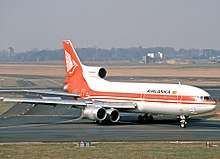
The TriStar 500 is equipped with the more powerful RB211-524B engines. Initially rated at 50,000 lbf (220 kN) thrust each, the higher-thrust 53,000 lbf (240 kN) -524B4 Improved (also referred to as the -524B4I) later became available, which also offered improved fuel efficiency.
Performance
Originally certified with an MTOW of 496,000 pounds (225,000 kg), an increased MTOW of 504,000 pounds (229,000 kg) was later certified in 1979, and all earlier production aircraft were certified at this weight. A further increase, to 510,000 pounds (230,000 kg), is also available, and most TriStar 500s are thought to have had this increase. Standard fuel capacity is 31,600 US gallons (120,000 l), giving the TriStar 500 a range of about 5,200 nautical miles (9,600 km) with 246 passengers and baggage.
Cabin
The TriStar 500's maximum passenger capacity is 315, although no aircraft were operated with that number of seats. A typical two-class layout might include 21 First Class and 229 Economy Class for a maximum of 250 passengers. More spacious three-class layouts used on longer routes include 233 with 12 First Class, 32 Business Class, and 189 Economy Class with Delta Air Lines. The aircraft is equipped with six exits, two fewer than the long-body TriStars, thus reducing the exit limit maximum.
Operators
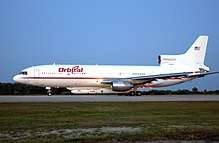
The last remaining L-1011 TriStar in service as of 2019 is the Stargazer air-launch mothership, operated by Northrop Grumman Innovation Systems (formerly Orbital ATK).[58][59][60]
Accidents and incidents
As of December 2011, the L-1011 was involved in 35 aviation occurrences,[61] including 10 hull-losses,[62] with 540 fatalities.[63] Of the four pioneering widebody aircraft (Boeing 747, McDonnell Douglas DC-10, L-1011, and Airbus A300/A310 family), the Lockheed L-1011 had comparatively few accidents and a better safety record than its competitors.[64][65][66]
- On December 29, 1972, Eastern Air Lines Flight 401, an L-1011, crashed in the Florida Everglades as a result of the flight crew's failure to monitor the flight instruments during a malfunction of the landing gear position indicator system. The crash resulted in 101 fatalities, and was the subject of two TV movies, Crash and The Ghost of Flight 401. It was also the subject of a Mayday episode.[67][68]
- On April 12, 1977, Delta Air Lines Flight 1080, on takeoff from San Diego, had a left stabilizer jammed undetected in the full trailing-edge-up position.[69] This failure resulted in a large noseup and rolling moment that almost exceeded the capability of the flight controls.[70] The airplane was just about to stall in the clouds when Captain Jack McMahan,[71] with unusual insight, reduced power on the wing engines and began using the throttles to supplement the remaining flight controls, using differential and collective engine thrust.[72] Cabin crew moved all the passengers forward in the cabin to redistribute weight and help get the nose down. Steve Heidt, the flight engineer, said, "It probably didn't help much, but in that situation, we figured every little bit would help."[69] All the way from San Diego to Los Angeles, the aircraft flew with its pitch controlled by differential thrust between tail and wing engines, while the left roll tendency was compensated by wing differential thrust, and made a successful emergency landing in Los Angeles.[73] According to an incident analysis by Warren VanderBurgh, comprehensive crew training played a critical role in control recovery.[74]
- On August 19, 1980, a fire destroyed the L-1011-200 used for Saudia Flight 163 on the ground after the pilots made an emergency landing at Riyadh's International Airport due to fire in the rear of the aircraft. Delays in initiating the evacuation of the aircraft led to the deaths of all 287 passengers and 14 crew.[75][76]
- On December 23, 1980, Saudia Flight 162, an L-1011, had a tire explode and penetrate the passenger cabin. The aircraft lost cabin pressure and two passengers were ejected through a hole in the cabin floor. The aircraft was later repaired and returned to service.[77]
- On September 22, 1981, Eastern Air Lines Flight 935 departed Newark, New Jersey, and suffered an uncontained failure of its number two (tail) engine at 14,500 feet (4,400 m), while en route to San Juan, Puerto Rico.[78][79] The fragments from that engine damaged three of its four hydraulic systems resulting in fluid loss in them. The rudder pedals also jammed. The fragments struck but did not puncture the lines for the other hydraulic system; the captain was able to safely land the aircraft at John F. Kennedy International Airport, with some limited use of the outboard spoilers, the inboard ailerons and the horizontal stabilizer, plus differential engine power of the remaining two engines. There were no injuries. The L-1011 having four hydraulic systems (instead of three like the DC-10) allowed for a safe landing.[80][81]
- On May 5, 1983, Eastern Air Lines Flight 855, L-1011 registration N334EA, while flying from Miami to Nassau, shut down the number 2 engine due to low oil pressure and began a return to Miami. Both of the remaining engines later failed. Without power, flight 855 descended from 13,000 to 4,000 feet (1,200 m) before the number 2 engine was restarted and the aircraft landed in Miami without injuries. Incorrect engine maintenance had led to the loss of oil on all three engines.[82]
- On April 5, 1984, a Saudia Lockheed L-1011 TriStar on final approach to Damascus from Jeddah was hijacked by a Syrian national. The hijacker demanded to be taken to Istanbul, Turkey, but changed his mind and requested to go to Stockholm. After landing in Istanbul to refuel, the pilot pushed the hijacker out the emergency exit whereupon he was arrested.[83]
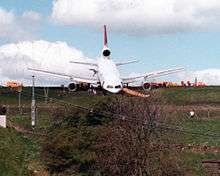
- On May 27, 1985, British Airtours Flight 101, registration G-BBAI, from Palma Airport, Mallorca, Spain overran the runway on landing at Leeds Bradford International Airport, West Yorkshire, United Kingdom. 12 of the 412 people on board suffered minor injuries when exiting down steep rear ramps. The aircraft was severely damaged.[84]
- On August 2, 1985, Delta Air Lines Flight 191, an L-1011, crashed while approaching Dallas/Fort Worth International Airport in microburst conditions. The crash killed eight of 11 crew members and 128 of the 152 passengers on board, as well as one person on the ground.[85][86]
- On October 18, 1985, a Jordanian Airlines L-1011 experienced an inflight fire at 24,000 feet while on approach to Singapore. The fire burned through the rear pressure bulkhead, causing explosive depressurization of the cabin. The air rushing out of the cabin extinguished the fire, saving the aircraft.[87]
- On May 3, 1986, Air Lanka Flight 512, an L-1011, was destroyed on the ground in Colombo, Sri Lanka, after a bomb exploded in the rear cargo hold, severing the tail and killing 21 people.[88]
- On June 28, 1991, LTU International L-1011 registration D-AERI, suffered an interior fire during maintenance in a hangar at Düsseldorf Airport. Four engineers escaped injury, but the aircraft was declared a total loss.[89]
- On July 30, 1992, TWA Flight 843, an L-1011, had its takeoff aborted by the captain after liftoff from JFK, in response to a false stall warning. The aircraft landed too hard, breaking a wing spar and starting a fire. All 292 passengers and crew evacuated safely, with only 10 minor injuries. The airliner was destroyed by fire.[90]
- On August 23, 1995, Delta Air Lines Flight 157, an L-1011 Tristar 1, suffered a rapid decompression after the pressure bulkhead failed. The flight crew initiated an emergency descent to 14,000 feet, and the plane landed safely at Los Angeles International Airport with no deaths or injuries to the 226 passengers or 10 crew. However, the aircraft was substantially damaged and later written off.[91]
Aircraft on display
- N1011 – L-1011-1 on display at the Delta Flight Museum in Atlanta, Georgia. This is the forward upper fuselage of the prototype aircraft and is painted in Delta colors.[92]
- C-FTNA – L-1011-1 on display at the Lyon–Saint-Exupéry Airport in Lyon, France. After Air Transat flight TSC906 was damaged in a hailstorm, the plane returned to Lyon and was written off. It is still used today for emergency training.[93][94]
- N31019 – L-1011-50 on display at the National Airline History Museum in Kansas City, Missouri at the Charles B. Wheeler Downtown Airport.[95]
- TT-DWE – L-1011-100 on display at the Emirates National Auto Museum in Abu Dhabi, United Arab Emirates. This aircraft was originally delivered to British Airways.[96]
- HZ-AHP – L-1011-200 in Saudia livery on display as a gate guardian at the Royal Saudi Air Force Museum in Riyadh, Saudi Arabia.[97]
- 9Y-TGN – L-1011-500 on display at the Chaguaramas Military History and Aerospace Museum in Chaguaramas, Trinidad. This aircraft was previously operated by BWIA West Indies Airways.[98][99]
- N91011 – L-1011-500 on display with Tristar History and Preservation at Kansas City International Airport. It was previously in storage at Southern California Logistics Airport in Victorville, California.[100][101][102]
- HS-AXE (Thai Sky Airlines), formerly N718DA (Delta) L-1011-1 was converted to a bar/restaurant located in Bangkok, Thailand.[103]
- 9Q-CHC (Hewa Bora Airways), MSN 1209 formerly C-GAGI (Air Canada) and N767DA (Delta) L-1011-385-3 Tristar 500 moved to Parc de la Vallée de la Nsele near Kinshasa, Democratic Republic of the Congo where it will be converted to a bar/restaurant.[104]
- CS-TMB (Luzair) MSN 1248 formerly JY-AGJ (Royal Jordanian) L-1011-385-3 Tristar 500 moved to Underwater Military Museum Dive Site, Aqaba, Jordan for use as a tourist dive site. No wings.[105]
Specifications
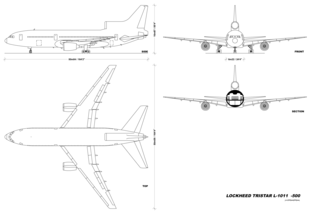
| Variant | L-1011-1 | L-1011-200 | L-1011-500 |
|---|---|---|---|
| Cockpit crew | Three (pilot, copilot, flight engineer) | ||
| Seating | 256 (mixed-class) | 246 (mixed-class) | |
| Exit limit | 400 | 330 | |
| Interior width | 18 feet 11 inches (5.77 m) | ||
| Length | 177 ft 8 1⁄2 in (54.17 m) | 164 ft 2 1⁄2 in (50.05 m) | |
| Wingspan | 155 ft 4 in (47.35 m) | 164 ft 4 in (50.09 m) | |
| Height | 55 ft 4 in (16.87 m) | ||
| Wing area | 3,456 sq ft (321.1 m2) | 3,541 sq ft (329.0 m2) | |
| MTOW | 430,000 lb (200,000 kg) | 466,000 lb (211,374 kg) | 510,000 lb (231,332 kg) |
| OEW | 241,700 lb (110,000 kg) | 248,400 lb (113,000 kg) | 245,400 lb (111,000 kg) |
| Fuel capacity | 23,814 US gal (90,150 l) | 26,502 US gal (100,320 l) | 31,642 US gal (119,780 l) |
| Engines (×3) | Rolls-Royce RB211-22 | RB.211-524B | |
| Thrust (×3) | 42,000 lbf (187 kN) | 50,000 lbf (222 kN) | |
| Mmo[107] | Mach 0.90 (516 kn; 956 km/h) | ||
| Cruise[lower-alpha 1] | 520 kn (963 km/h) | 515 kn (954 km/h) | 525 kn (972 km/h) |
| Stall[lower-alpha 2] | 108 kn (200 km/h) | 110 kn (204 km/h) | 114 kn (211 km/h) |
| Range[lower-alpha 3] | 2,680 nmi (4,963 km) | 3,600 nmi (6,667 km) | 5,345 nmi (9,899 km) |
| Ferry range[lower-alpha 4] | 4,250 nmi (7,871 km) | 4,935 nmi (9,140 km) | 6,090 nmi (11,279 km) |
| Ceiling[107] | 42,000 ft (12,800 m) | 43,000 ft (13,100 m) | |
- 30,000 ft (9,100 m)
- max. landing weight, flaps and gear down
- max. passengers + baggage
- max. fuel
Deliveries
| 1972 | 1973 | 1974 | 1975 | 1976 | 1977 | 1978 | 1979 | 1980 | 1981 | 1982 | 1983 | 1984 | 1985 | Total |
|---|---|---|---|---|---|---|---|---|---|---|---|---|---|---|
| 17 | 39 | 41 | 24 | 16 | 12 | 8 | 14 | 24 | 28 | 13 | 5 | 5 | 3 | 249 |
Popular culture
- The band El Ten Eleven, a Los Angeles post-rock duo, derives its name from the L-1011.[108]
See also
Related development
Aircraft of comparable role, configuration and era
Related lists
References
Notes
- The British government did approve a large state subsidy because if Lockheed (which was itself weakened by the difficulties) had failed, the market for the RB211 would have evaporated.[20]
Citations
- "Airliner price index". Flight International. August 10, 1972. p. 183.
- Greenwald, John; Hannifin, Jerry & Kane, Joseph J. (December 21, 1981). "Catch a Falling TriStar". Time. Retrieved January 6, 2007.
- "L-1011: Luxury Among the Clouds".
- "Accident Synopsis 09291959". AirDisaster.com. 2008. Retrieved July 16, 2011.
- "NASA Wind Tunnel Tests". National Aeronautics and Space Administration. Retrieved July 16, 2011.
- "Disasters: Electra's Tragedy". Time. October 17, 1960.
- "Lockheed L-1011". Chasing the Sun. PBS. Retrieved July 16, 2011.
- "Requiem for a Trijet Masterpiece - the Lockheed L-1011". September 30, 2015.
- "The Lockheed L1011 - Saying Goodbye to Another Trijet". March 24, 2014.
- The Aeronautical Journal. Vol. 78. Royal Aeronautical Society. 1974. pp. 392, 398. Retrieved July 16, 2011.
- SAE Transactions. Society of Automotive Engineers. 1970. p. 1436. Retrieved December 11, 2008.
- "Three Shaft Engine Design". Rolls-Royce. Retrieved July 16, 2011.
- Pugh, Peter (2001). The Magic of a Name: The Rolls-Royce Story, Part Two: The Power Behind the Jets. London: Icon Books. pp. 120–122. ISBN 1-84046-284-1.
- "The New Steel". Flight International. October 24, 1968.
- Boyne, Walter J. (1998). Beyond the Horizons: The Lockheed Story. New York: St. Martin's Press. p. 354. ISBN 978-0-312-19237-2.
- "Lockheed's Rough Ride with Rolls-Royce". Time. February 15, 1971.
- Wood, Robert (November 12, 1970). "Jumbo Jet engines for Lockheed push Rolls-Royce in red". Los Angeles Times.
- Lindsey, Robert (February 5, 1971). "Lockheed Seeks U.S. Engine Now: Retooling Cost of a Switch Could Run to $100-million". The New York Times.
- "Canadian 'key' has no plans". Montreal Gazette. February 9, 1971.
- Lewis, Antony (November 12, 1970). "British Grant Set for Rolls-Royce: Government to Spend up to $100-Million in Rescue Bid". The New York Times.
- "New Life for TriStar". Time. May 17, 1971. Retrieved July 16, 2011.
- "Rolls-Royce Still Alive and Kicking". Montreal Gazette. February 18, 1972.
- "Engine Update". Aircraft Engineering and Aerospace Technology. Vol. 48. 1976. p. 5.
- Jones, Jack (December 8, 1981). "Saddened Lockheed workers still view L-1011 with pride". 'Los Angeles Times.
- "Lockheed to stop l-1011 production". Sumter Daily Item. December 8, 1981.
- Young, David (September 18, 1977). "Look Ma, no hands—learning how to land a jumbo jet". Chicago Tribune.
- "LTN-92 Laser Gyro INS" (PDF). Northrop Grumman. Archived from the original (PDF) on September 27, 2011. Retrieved July 16, 2011.
- Report: Lockheed L1011-500 Tristar, CS-TMP (PDF). Air Accidents Investigation Branch. Archived from the original (PDF) on December 22, 2009. Retrieved July 16, 2011.
- Report: Lockheed L1011-385-1-14, G-BBAF (PDF) (Report). Air Accidents Investigation Branch. p. 5. Retrieved July 16, 2011.
- Kocivar, Ben (December 1970). "Giant Tri-Jets Are Coming". Popular Science. Vol. 197 no. 6. pp. 50–52. ISSN 0161-7370.
- Donald, David, ed. (1997). "Lockheed L-1011 TriStar". The Complete Encyclopedia of World Aircraft. New York: Barnes & Noble Books. p. 579. ISBN 0-7607-0592-5.
- "L-1011: Luxury Among the Clouds".
- "Lockheed L-1011". Super70s.com. Retrieved December 4, 2011.
- "Delta History: Lockheed L-1011". Delta Museum. Retrieved July 16, 2011.
- Nevin, Loouis (February 27, 1976). "Payoff scandal could prove costly to Lockheed; Japanese might halt orders". The Bulletin.
- "Lockheed's Japanese data asked in Senate subpoena". The New York Times. April 3, 1976. Retrieved July 16, 2011.
- Kamm, Henry (January 24, 1977). "Lockheed Scandal in Japan headed for its trial phase". The New York Times.
- Lindsey, Robert (July 3, 1977). "Kotchian calls himself the Scapegoat". The New York Times.
- "Bribery Shokku At the Top". Time. August 9, 1976. Retrieved July 16, 2011.
- Hunziker, Steven; Kamimura, Ikuru. "The Lockheed Scandal". Kakuei Tanaka: A Political Biography Of Modern Japan. Retrieved July 16, 2011.
- "Lockheed loses big Japanese contract". St. Petersburg Times. February 11, 1976.
- "Facts: The Ilyushin Il-86". CNN. July 28, 2002. Retrieved July 16, 2011.
- "Soviet Wide-Bodied Jet begins regular service to East Berlin". Los Angeles Times. July 4, 1981.
- Birtles, Philip (1989). Lockheed TriStar. Modern Civil Aircraft No 8. London: Ian Allan. ISBN 978-1-85310-934-8.
- "A British paper said Russia may buy the jet engine used in the Tristar". Los Angeles Times. November 1, 1973.
- Neikirk, Bill (March 27, 1977). "World hears Carter human rights call". Chicago Tribune.
- Jacoby, Tamar (June 1986). "Did Carter fail on human rights?". Washington Monthly.
- Frawley, Gerard (2002). The International Directory of Military Aircraft, 2002–2003. Fyshwick, ACT, Australia: Aerospace Publications. p. 44. ISBN 1-875671-55-2.
- Prokesch, Steven (July 7, 1990). "British Air Purchasing Boeing 747s". The New York Times.
- "TriStar Tankers...The RAF Goes Widebody". Air International. Vol. 29 no. 6. Bromley, UK: Fine Scroll. December 1985. pp. 271–277.
- Craig, Hoyle (March 27, 2008). "UK signs £13 billion tanker deal". FlightGlobal.
- Hoyle, Craig (March 24, 2014). "RAF TriStars to fly final sortie". Flight International. Retrieved March 25, 2014.
- "Tristar used to launch Pegasus". Orbital.com. Retrieved July 16, 2011.
- "Orbital Sciences Corporation L-1011, Stargazer carries HESSI spacecraft from Vandenberg AFB to the Kennedy Space Center". Air and Space. February 1, 2002.
- "Dryden L-1011 Tristar". NASA Photo Collection. National Aeronautics and Space Administration. July 16, 2011.
- Howarth, Nigel (April 15, 2014). "Contrasting fortunes for old freighters in the California desert". Aviation Week & Space Technology. Archived from the original on May 24, 2014. Retrieved May 24, 2014.
- "US Airways History". US Airways. Retrieved July 16, 2011.
- "Pegasus/L-1011". Orbital ATK. 2015. Retrieved March 28, 2015.
- Clark, Stephen (April 3, 2012). "Pegasus Launch Report: Launch of NASA X-ray telescope targeted for June". Spaceflight Now. Retrieved March 28, 2015.
- Clark, Stephen (October 10, 2019). "Rockets purchased by Stratolaunch back under Northrop Grumman control". Spaceflight Now. Retrieved October 15, 2019.
- "Lockheed L-1011 Tristar incidents". Aviation-Safety.net. July 9, 2020. Retrieved July 11, 2020.
- "Lockheed L-1011 Tristar hull-losses". Aviation-Safety.net. July 9, 2020. Retrieved July 11, 2020.
- "Lockheed L-1011 Tristar Statistics". Aviation-Safety.net. July 9, 2020. Retrieved July 11, 2020.
- "1970: Lockheed L-1011 Tristar". LockheedClassics.com. Archived from the original on April 28, 2012. Retrieved August 25, 2012.
- "Lockheed L.1011 Tristar". Century of Flight. Retrieved August 25, 2012.
- Birtles, Phillip (1998). Lockheed L-1011 TriStar. Airliner Color History. St. Paul, Minnesota: Motorbooks International. p. 111. ISBN 978-0-7603-0582-9.
- Job, Macarthur (1994). "Chapter 12: Hey – what's happening here?". Air Disaster. Vol. 1. Fyshwick, ACT, Australia: Aerospace Publications. pp. 99, 101–102. ISBN 1-875671-11-0.
- {{cite news |url = https://www.nbcnews.com/id/22394676 |title = 35 years after jetliner crash, hero gets his due |agency = [[Associated Press |publisher = NBC News |date = December 25, 2007 }}
- "The Saving Of Flight 1080". Washington Post. October 8, 1978.
- Burcham, Frank W., Jr.; Maine, Trindel A.; Fullerton, C. Gordon & Webb, Lannie Dean (September 1996). Development and Flight Evaluation of an Emergency Digital Flight Control System Using Only Engine Thrust on an F-15 Airplane (PDF). National Aeronautics and Space Administration. NASA TP-3627.
- http://www.aahs-online.org/journals/journal_template.php?vol_no=v50n4#Article 4
- Burcham et al. (1996), p. 11.
- Jonckheere, Edmond A.; Lohsoonthorn, Poonsuk & Bohacek, Stephan K. (1999). "From Sioux City to the X-331" (PDF). Annual Reviews in Control. Vol. 23. pp. 91–108.
- "Control Malfunctions & Flight Instrument Anomalies" – via YouTube.
- "265 on Saudi jet die in fiery landing". Milwaukee Journal. August 20, 1980.
- "260 feared dead as burning jet's doors jam shut". Spokesman-Review. August 20, 1980.
- "2 Children die in freak mishap aboard Saudi Arabian jetliner". Los Angeles Times. December 24, 1980.
- "ASN Aircraft accident: Eastern Airlines L-1011, September 22, 1981". Aviation-Safety.net. Retrieved July 16, 2011.
- "NTSB Identification: DCA81AA027". National Transportation Safety Board. Retrieved December 19, 2011.
- "More DC-10 troubles hinted". Chicago Tribune. November 28, 1981.
- "Engines of jumbo jets have troubled history". Milwaukee Journal. November 28, 1981.
- Thompson, Steven. "The Story of Eastern Flight 855". FlyTristar. Retrieved July 16, 2011.
- Hijacking description at the Aviation Safety Network
- "Report on the Accident to Lockheed Tristar G-BBAI at Leeds Bradford Airport on 27 May 1985" (PDF). Accidents Investigation Branch. Retrieved July 17, 2017.
- Delta Air Lines Flight 191 Crash (PDF). National Transportation Safety Board. Archived from the original (PDF) on August 17, 2014. Retrieved August 25, 2012.
- Magnuson, Ed (April 18, 2005). "Like a Wall of Napalm". Time.
- Hill, Richard D. Investigations and characteristics of major fire-related accidents in civil air transports over the last ten years (PDF). Federal Aviation Administration Technical Center. Retrieved August 25, 2012.
- "1986: Bomb kills 21 in Sri Lanka". BBC. May 3, 1986.
- "Accident information : Lockheed L-1011 TriStar LTU International D-AERI". Aviation Safety Network. Retrieved June 17, 2019.
- Aircraft Accident Report, Trans World Airlines Flight 843 (PDF). National Transportation Safety Board. March 31, 1993. Archived from the original (PDF) on June 15, 2007.
- "Accident Description". Aviation Safety Network. August 23, 1995. Retrieved July 7, 2020.
- "Prototype Lockheed L-1011". Delta Flight Museum. Retrieved June 9, 2016.
- "Accident information : Lockheed L-1011 TriStar Air Transat C-FTNA". Aviation Safety Network. Retrieved June 18, 2018.
- Google (June 18, 2018). "45.7112164°N, 5.0838171°E" (Map). Google Maps. Google. Retrieved June 18, 2018.
- "Lockheed L-1011 TriStar". Airline History Museum. Archived from the original on August 15, 2016. Retrieved September 20, 2016.
- Löffler, Dennis (April 6, 2010). "Photo: TT-DWE (CN: 193N-1093) Lockheed L-1011-385 Tristar by Dennis Löffler Photoid:6854229". JetPhotos.Net. Retrieved September 20, 2016.
- "Airframe Dossier: Lockheed L-1011-200 TriStar, c/n 1190, c/r HZ-AHP". Aerial Visuals. Retrieved September 20, 2016.
- "Chaguaramas Military History & Aerospace Museum". Trinidad and Tobago Sights. Fodor's. Retrieved July 16, 2011.
- "Lockheed L-1011-500 Tristar Original model: L1011-500 9Y-TGN". JetPhotos.Net. Retrieved September 20, 2016.
- "Jumbo jet arrives at KCI to serve as STEM classroom for students". July 16, 2017.
- "TriStar L1011 / N91011". TriStar History. Retrieved March 28, 2015.
- "TriStar History and Preservation, Inc. to preserve a former TAP Air Portugal Lockheed L-1011 TriStar in TWA colors at Kansas City". World Airline News. January 10, 2015. Retrieved June 9, 2016.
- "Changchui | Thailand | ช่างชุ่ย ChangChui". ChangChui.
- https://www.aviation24.be/defunct-airlines/hewa-bora/hidden-gem-lockheed-l-1011-tristar-parc-de-la-vallee-de-la-nsele-congo-kinshasa. Missing or empty
|title=(help) - https://www.jetphotos.com/photo/9446772. Missing or empty
|title=(help) - Taylor, John W. R. (1982). Jane's All The World's Aircraft 1982–83. London: Jane's Yearbooks. pp. 405–406. ISBN 0-7106-0748-2.
- "Type Certificate No. A23WE" (PDF). Federal Aviation Administration. January 11, 2010.
- Levine, Matthew (November 6, 2012). "El Ten Eleven Transitions (Fake, 2012)". Bar None Records. Archived from the original on May 23, 2013. Retrieved November 13, 2012.
Further reading
- Bright, C. D. (1978). The Jet Makers: The Aerospace Industry from 1945 to 1972. Lawrence: University Press of Kansas. ISBN 0-7006-0172-4.
- Ingells, D. J. (1973). L-1011 TriStar and the Lockheed Story. Blue Ridge Summit, Pennsylvania: TAB-Aero. ISBN 978-0-8168-6650-2.
- Newhouse, John (1982). The Sporty Game: The High-Risk Competitive Business of Making and Selling Commercial Airliners. New York: Alfred A. Knopf. ISBN 978-0-394-51447-5.
- Yenne, Bill (1987). Lockheed. New York: Crescent Books. ISBN 0-517-60471-X.
External links
| Wikimedia Commons has media related to Lockheed L-1011 TriStar. |
- L-1011 page on airliners.net
- L-1011 page on airfleets.net
- Active L-1011 page on airfleets.net
- L-1011 FFA Registry page on ffa.gov
- "Presenting the Lockheed L-1011" a 1967 Flight article
- "L-1011-500 TriStar technical profile" (PDF). Lockheed.
- "Lockheed L-1011 TriStar". Forecast International. August 2001.
- Lockheed L-1011 TriStar500.net site
